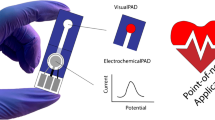Abstract
Though the advances in microelectronic device fabrication have realized new capabilities in integrated analytical and diagnostic platforms, there are still notable limitations in point-of-care sample preparation. AC electrokinetic devices, especially those leveraging dielectrophoresis (DEP), have shown potential to solve these limitations and allow for sample-to-answer in a single point-of-care device. However, when working directly with whole blood or other high conductance (~ 1 S/m) biological fluids, the aggressive electrochemical conditions created by the electrode can fundamentally limit the device operation. In this study, platinum wire-based electrode devices spanning circular polytetrafluorethylene (PTFE) wells and a planar microarray device with sputtered platinum electrodes were tested in plasma and PBS buffers of differing concentration across a wide range of frequencies and electric field intensities (AC voltages) to determine their respective safe regions of operation and to gain an understanding about the failure mechanisms of this class of device. At frequencies of 10 kHz and below, the upper bound of operation is the degradation of electrodes due to electrochemical attack by chlorine overcoming the native platinum oxide passivation. At higher frequencies, 100 kHz and above, the dielectric loss and subsequent heating of the buffer will boil before the electrodes suffer observable damage, due to the slow irreversible reaction kinetics. Effective dielectrophoretic capture of small biological particles at these frequencies is limited, and heat/oxidative denaturation of target material are a major concern. A new class of smaller devices, ones capable of high throughput at voltages low enough to maintain the integrity of the platinum passivation layer, is needed to mitigate these fundamental limitations.







Similar content being viewed by others
References
Ye S. Evaluating platelet activation related to the degradation of biomaterials using molecular markers. Colloids Surfaces B Biointerfaces. 2019;184:110–5.
Nayak S. Point-of-care diagnostics: recent developments in a connected age. Anal Chem. 2017;89(1):102–3.
Lewis JM. Detecting cancer biomarkers in blood: challenges for new molecular diagnostic and point-of-care tests using cell-free nucleic acids. Expert Rev Mol Diagn. 1:187–200.
Zhou MZMF. Determination of tryptophan, glutathione, and uric acid in human whole blood extract by capillary electrophoresis with a one - step electrochemically reduced graphene oxide modified microelectrode. Chromatographia. 2016;79:911–8.
Serru V. Quantification of reduced and oxidized glutathione in whole blood samples by capillary electrophoresis. Clin Chem. 2001;47:1321–4.
Modestino A. Thrombin generation assay in untreated whole human blood. Electroph. 2016:2248–56.
Vrouwe EX. Direct measurement of lithium in whole blood using microchip capillary electrophoresis with integrated. Electroph. 2004;25:1660–7.
Cheng HL. On-line stacking capillary electrophoresis for analysis of methotrexate and its eight metabolites in whole blood. Electroph. 2008;29:3665–73.
Lewis JM. Integrated analysis of exosomal protein biomarkers on alternating current electrokinetic chips enables rapid detection of pancreatic cancer in patient blood. ACS Nano. 2018;12:3311–20.
Mohammadi M. Hydrodynamic and direct-current insulator-based dielectrophoresis (H-DC-iDEP) microfluidic blood plasma separation. Anal Bioanal Chem. 2015;407:4733–44.
Ibsen S. Recovery of drug delivery nanoparticles from human plasma using an electrokinetic platform technology. Small. 11:5088–96.
Ibsen SD. Rapid isolation and detection of exosomes and associated biomarkers from plasma. ACS Nano. 2017;11(7):6641–51.
Manouchehri S. Dielectrophoretic recovery of DNA from plasma for the identification of chronic lymphocytic leukemia point mutations. Int J Hematol Oncol. 2015;5:27–35.
Sonnenberg A. Dielectrophoretic isolation and detection of cancer-related circulating cell-free DNA biomarkers from blood and plasma. Electrophoresis. 2014;35:1828–36.
Lewis J. A pilot proof-of-principle analysis demonstrating dielectrophoresis (DEP) as a glioblastoma biomarker platform. Sci Rep. 2019;9:1–10.
Pethig R. Dielectrophoresis: status of the theory, technology, and applications. Biomicrofluidics. 2010;4:228–11.
Wei XF. Impedance characteristics of deep brain stimulation electrodes in vitro and in vivo. J Neural Eng. 2009;6:30–46.
Juchniewicz R. The influence of increasing superimposed 50 c/s a.c. on the anodic dissolution of platinum in 3% sodium chloride. Cor Sci. 1966;6:69–77.
Hayes M. Aggregation effects on the electrocatalytic activity of platinum. Acc Chem Rev. 2013;53:88–95.
Stanca SE. Chemical and electrochemical synthesis of platinum black. Sci Rep. 2017;7:1–8.
Briner E. Recherches sur lectrolyse avec courant ondulé. Observations sur attaque des électrodes de platine et la formation de ozone sous effet du courant alternatif et du courant. Helvetica. 1944;26:1829–35.
Juchniewicz R. The influence of alternating current on the anodic behaviour of platinum. Plat Met Rev. 1962;6:100–5.
Llopis J. Electrochemical corrosion of platinum in hydrochloric acid solutions. ECS. 1961;108:720.
Pyell U. Characterization of nanoparticles by capillry electromigration separation techniques. Electrophoresis. 2010;31:814–31.
Wissel K. Platinum corrosion products from electrode contacts of human cochlear implants induce cell death in cell culture models. PLoS One. 2018;13:1–20.
Rand DAJ. A study of the dissolution of platinum, palladium, rhodium and gold electrodes in 1M sulphuric acid by cyclic voltammetry. J Elect Chem Int Elect. 1972;35(1):209–18.
Kuhn AT. The behaviour of platinum, iridium and ruthenium electrodes in strong chloride solutions. J Elect Chem Int Elech. 1973;41:329–49.
Brown SA. Electrochemical corrosion in saline and serum. J Biomed Mater Res. 1980;14:173–5.
Black RC. Dissolution of smooth platinum electrodes in biological fluids. Appl Neurophys. 1980;42:366–74.
Llopis J. Corrosion of platinum metals and chemisorption. Cat Rev. 1968;2:161–220.
Bentley R. The alternating current electrolysis of concentrated acids. J Appl Chem. 2007;7:619–26.
Pourbaix MJN. Electrochemical properties of the platinum metals. Plat Met Rev. 1959;3:47–53.
Llopis J. Study of the impedance of a platinum electrode in the system. Electro Acta. 1959;8:130–50.
Benke G. The electrochemical dissolution of platinum. Hydrometallurgy. 2002;64:205–18.
Franks W. Impedance characterization and modeling of electrodes for biomedical applications. Trans biomed Eng. 2005;52:1295–302.
Czarnetzki LR. Formation of hypochlorite, chlorate and oxygen during NaCl electrolysis from alkaline solutions at an RuO2/TiO2 anode. J App Elect. 1992;22:315–24.
Cherevko S. A comparative study on gold and platinum dissolution in acidic and alkaline media. J Electrochem Soc. 2014:161–82.
Heineck DP. High-conductance electrokinetic device characterization and design. University of California San Diego. 2017. https://escholarship.org/uc/item/0xp4r2hb. Accessed 28 Feb 2020.
Funding
This work was funded through MJ Heller’s UCSD invention royalties.
Author information
Authors and Affiliations
Corresponding author
Ethics declarations
Conflict of interest
Michael Heller is a member of the scientific advisory board for Biological Dynamics. The other authors declare that they have no conflict of interest. This work is based on the thesis of Daniel Heineck, “High-Conductance Electrokinetic Device Characterization and Design” [38].
Additional information
Published in the topical collection Bioanalytics and Higher Order Electrokinetics with guest editors Mark A. Hayes and Federica Caselli.
Publisher’s note
Springer Nature remains neutral with regard to jurisdictional claims in published maps and institutional affiliations.
Rights and permissions
About this article
Cite this article
Heineck, D.P., Sarno, B., Kim, S. et al. Electrochemical attack and corrosion of platinum electrodes in dielectrophoretic diagnostic devices. Anal Bioanal Chem 412, 3871–3880 (2020). https://doi.org/10.1007/s00216-020-02607-7
Received:
Revised:
Accepted:
Published:
Issue Date:
DOI: https://doi.org/10.1007/s00216-020-02607-7




